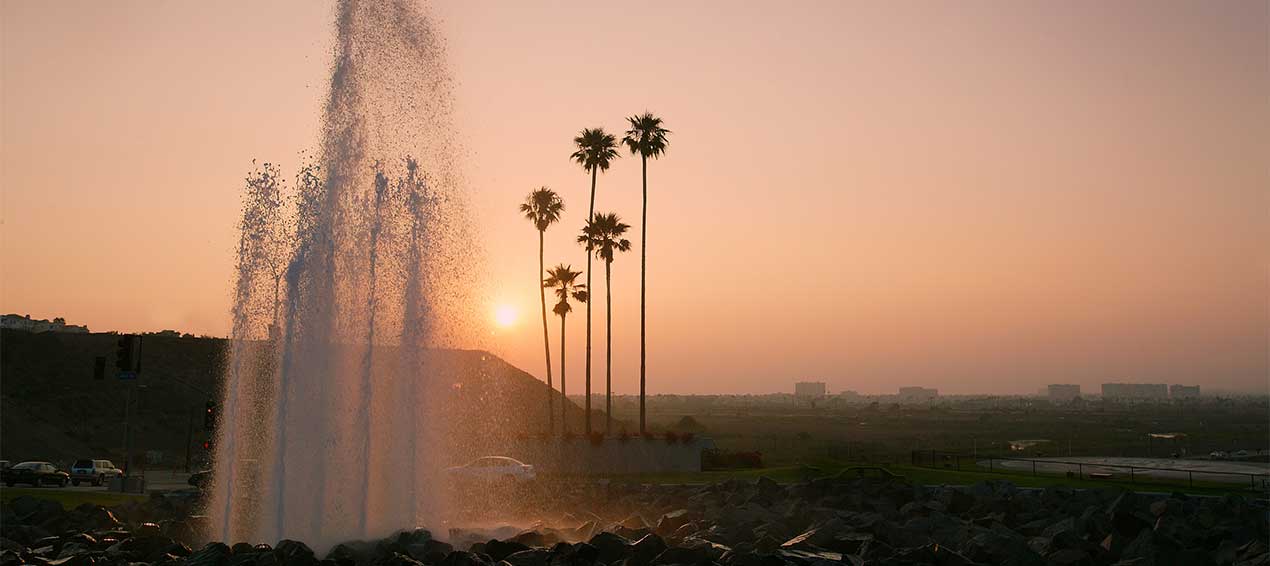
LMU's Lincoln Fountain is an environmentally responsible, recirculating water structure that serves as a focal point at the university's main entrance on Lincoln Boulevard (CA-1/Pacific Coast Highway) and LMU Drive. Reminding us of the centrality of water in our lives, the fountain is a symbol of life and renewal and welcomes all who visit the LMU community. In its majesty, the Lincoln fountain demands attention from passersby, and it is an iconic landmark associated with LMU and Los Angeles.
As the Lincoln fountain boldly engages visitors near and far, LMU has undertaken significant steps to offset the fountain's minimal water usage and to raise awareness of California's drought. For more information about LMU's nationally acclaimed sustainability, green, and recycling efforts, please visit LMU's Green Website. In collaboration with municipal water districts and authorities, LMU continues to lead and maximize water conservation efforts and programs.
Fountain Facts and Related Information
- The fountain requires about 45,000 gallons of water, a little more than the average swimming pool, and it recirculates the water, so there is minimal water consumption. For context and through evaporation, the fountain uses the same amount of water as 1.7 showers/week.
- In the past few years, LMU has reduced its water consumption by more than a million gallons per year (estimated), which represents many times the total water consumption of the Lincoln Fountain.
- Due to evaporation and splashing, the fountain loses roughly 3 percent of its water volume annually, the equivalent of a brief shower per week.
- The fountain is operated periodically to remain in working order. It is more ecologically responsible to fill it once and operate it on a limited basis than to fill it three or four times a year for maintenance.
Other Measures Taken to Reduce Water Consumption at LMU
- We removed 210,000 square feet of turf on Drollinger Field, which saved an estimated 1 million gallons of water.
- 75% of our campus landscape uses reclaimed water for irrigation.
- We installed low-flow aerators on sinks and low-flow shower heads across campus to reduce sink and shower water consumption by 55 percent.
- We expanded low-volume-per-flush toilets across the campus.
- We replaced aging washing machines with Energy Star Units that save an estimated 880 thousand gallons a year.
- We removed turf/grass and plants with heavy water requirements and replaced them with drought-tolerant plants.
- We deployed rainwater/atmospheric condition sensors for landscape irrigation to reduce water usage.
- We maintain chilled and hot water loops with storage tanks to reduce water loss.
- We placed rain barrels in our campus garden to reduce potable water use.
- We further integrated environmental sustainability topics into our curriculum:
- students gather condensate from HVAC equipment on the roof of the Life Sciences Building and use it to irrigate nearby plants;
- environmental science major/minor, engineering programs, biology, chemistry, and other programs, business classes on sustainability in undergraduate and graduate programs, CURes, sustainability certificate programs, The Bay Foundation, Urban Studies program.
- Our green rooftops on Drollinger Parking Plaza and the Life Sciences Building reduce runoff.
- We promote water saving programs in partnership with our student government to reduce water use by students.